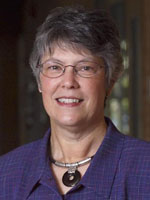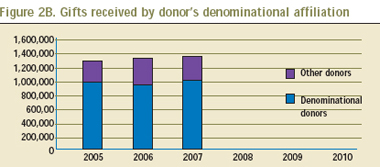 |
| Rebekah Burch Basinger is In Trust's program director. She lives in Dillsburg, Pennsylvania. |
When it comes to fundraising, there's no disputing that numbers matter, but numbers sans context are of limited value, or worse, can be downright misleading. That's why wise boards identify which fundraising numbers matter most for their school at a particular moment in time. And they expect the information to come to them in a format that makes reading between the numbers easy to do.
At their best, boards understand the importance of keeping an eye on a select set of strategic indicators that are linked to the future vision of the institution. There is no one-size-fits-all list of what those should be. It all comes down to what the board and administration are trying to achieve through the fundraising program.
To be of greatest use to a board, strategic indicators (sometimes referred to as "dashboard indicators") should
-
Flow from the school's strategic plan.
-
Highlight current progress, but also be prophetic.
-
Encourage action on the part of the board and the campus community.
-
Facilitate assessment of fundraising activities and strategies.
The authors of The Nonprofit Dashboard: A Tool for Tracking Progress remind us, "By keeping the information simple, board members can focus on what is important to know without becoming overwhelmed with information that may distract them from the work at hand." The strategies for growing a school's donor base and increasing gift income are unique to each school, and, as the charts that follow illustrate, the indicators of success that a board chooses to track must be unique as well.
A plan for going deeper and wider within the annual fund
Annual giving at Theological School A has been flat over the past five years, with few new donors added to the support base and limited growth in the number of major ($1,000 and up) gifts to the general fund. Everyone, including the school's two full-time development officers, agrees that the trends have to change. So the FY07 budget was built on the assumption that the seminary community, including the board, would get serious about adding both depth and width to the school's donor mix. With a nod to the new emphases, the board added three tracking categories to its annual fund dashboard: number of new donors, number of $1,000 gifts, and number of $5,000+ gifts. It retained the categories of total giving and participation percentages for the board and alumni.
Nine months into the fiscal year, the board can see at a glance that the fundraising program is progressing well. Giving is up by $11,000 over this time last year and within an easy $29,000 of the anticipated $554,000 goal. The school has enjoyed particular success in attracting major gifts to the annual fund, with the goals for $1,000 and $5,000 plus gifts met or surpassed. However, barring a major push for new donors over the next few months, it's likely the school will fall short in this area.
Reading between the numbers: It's immediately clear that school experienced a good return on investment by focusing staff and volunteer time on increasing the number of $1,000-and-up donors. What is less obvious is whether the same rate of return on investment can be achieved from efforts to bring new donors (including alumni) into the support base. For an accurate reading of the numbers provided in Figure 1, the advancement committee needs to ask more questions, including:
What strategies have been used to attract new donors at less than $1,000? At $1,000 and more? At $5,000 and more? What has been the success rate for the various strategies? What strategies have been used to encourage existing donors to increase their giving? What has been the success rate for the various strategies? What is the average dollar amount of gifts by new donors? What is the average dollar amount of gifts by alumni donors?
A plan for diversifying giving beyond a historic support base
As is true for the majority of denominationally affiliated seminaries, the percentage of students who come from the parent denomination to Theological School B has dropped to less than half of FTE enrollment. On the other hand, 96 percent of the school's support base comes from the founding church. Believing it is important that church communities which are benefiting from the ministries of Theological School B's graduates begin to support the school financially, the board and administration are working toward the goal of achieving a 75/25 percent split in the origin of annual gifts by 2010.
Reading between the numbers: Over the past three years, based on a percentage split of origin of gifts to the school, it appears that efforts to attract donors from beyond the school's historic support base is not going well. However, this is an example of how numbers can mislead a board.
Reading between the numbers: By focusing only on number of donors, without also tracking the value of gifts received, board members can misjudge the impact of the school's efforts to attract support from beyond the historic giving base. Figure 2B shows the board that though the percentage of donors in the "other denominational" category is not keeping pace with projections, the monetary value of gifts from this group is growing at a faster rate than the value of gifts from denominational donors.
 |
Reading between the numbers: There's more good news for the school in yet another set of numbers. Figure 2C highlights the distribution of $1,000 gifts by denominational affiliation of the donor, and here the board can see donors in the "other denominational" category are increasing at a faster rate within this category of giving than are donors from the school's historic constituency. All this suggests that the board and administration may want to restate their goal to better focus cultivation and solicitation efforts for a maximum return.
A plan for understanding unevenness in giving from year to year
When it comes to the seminary's giving program, it is been one surprise after another for Theological School C. Some years have seen hefty unexpected bequests, along with a couple of million-dollar-plus grants from a family foundation, while others have seen very little in the way of nonrepeatable support, and now the board is perplexed about setting annual fundraising goals for the school. An accountant has developed a variation of the "snake-in-the-tunnel" policy that the board uses in determining endowment spending as a way to even out budget projections for nonrepeatable gifts. (See the New Year 2005 issue of In Trust , page 17, for more information on this policy.)
Here's how it works. The board calculated the average amount of the nonrepeatable gifts received in each of the past seven years, minus the two large foundation grants. This gave the board a working number of $281,500. It was determined that a spending tunnel in which the ceiling and the floor were 10 percent below and above the five-year average provided a safe space within which to set a goal for nonrepeatable gifts.
Reading between the numbers: In most years, the 20 percent width of the "tunnel" provides the school with a bit of wiggle room for making up a gap in anticipated giving, while keeping the stated goal at a historically justifiable level.